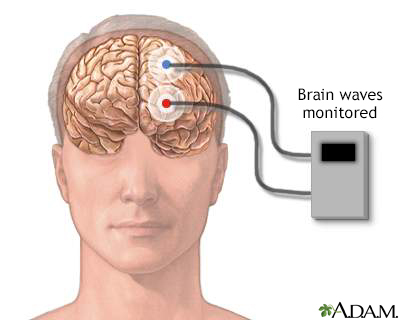Definition
An electroencephalogram (EEG) is a test to measure the electrical activity of the brain.
Alternative Names
Electroencephalogram; Brain wave test; Epilepsy - EEG; Seizure - EEG
How the Test is Performed
The test is done by an electroencephalogram (EEG) technologist in your doctor's office or at a hospital or laboratory.
The test is done in the following way:
- You lie on your back on a bed or in a reclining chair.
- Flat metal disks called electrodes are placed all over your scalp. The disks are held in place with a sticky paste. The electrodes are connected by wires to a recording machine. The machine changes the electrical signals into patterns that can be seen on a monitor or drawn on paper. These patterns look like wavy lines.
- You need to lie still during the test with your eyes closed. This is because movement can change the results. You may be asked to do certain things during the test, such as breathe fast and deeply for several minutes or look at a bright flashing light.
- You may be asked to sleep during the test.
If your doctor needs to monitor your brain activity for a longer period, an ambulatory EEG will be ordered. In addition to the electrodes, you will wear or carry a special recorder for up to 3 days. You will be able to go about your normal routine as the EEG is being recorded. Or, your doctor may ask you to stay overnight in a special EEG monitoring unit where your brain activity will be monitored continuously.
How to Prepare for the Test
Wash your hair the night before the test. DO NOT use conditioner, oils, sprays, or gel on your hair. If you have a hair weave, ask your health care provider for special instructions.
Your provider may want you to stop taking certain medicines before the test. DO NOT change or stop taking any medicines without first talking to your provider. Bring a list of your medicines with you.
Avoid all food and drinks containing caffeine for 8 hours before the test.
You may need to sleep during the test. If so, you may be asked to reduce your sleep time the night before. If you are asked to sleep as little as possible before the test, DO NOT eat or drink any caffeine, energy drinks, or other products that help you stay awake.
Follow any other specific instructions you are given.
How the Test will Feel
The electrodes may feel sticky and strange on your scalp, but should not cause any other discomfort. You should not feel any discomfort during the test.
Why the Test is Performed
Brain cells communicate with each other by producing tiny electrical signals, called impulses. An EEG measures this activity. It can be used to diagnose or monitor the following health conditions:
EEG is also used to:
- Evaluate problems with sleep (sleep disorders)
- Monitor the brain during brain surgery
An EEG may be done to show that the brain has no activity, in the case of someone who is in a deep coma. It can be helpful when trying to decide if a person is brain dead.
EEG cannot be used to measure intelligence.
Normal Results
Brain electrical activity has a certain number of waves per second (frequencies) that are normal for different levels of alertness. For example, brain waves are faster when you are awake and slower in certain stages of sleep.
There are also normal patterns to these waves.
Note: A normal EEG does not mean that a seizure did not occur.
What Abnormal Results Mean
Abnormal results on an EEG test may be due to:
- Abnormal bleeding (hemorrhage)
- An abnormal structure in the brain (such as a brain tumor)
- Tissue death due to a blockage in blood flow (cerebral infarction)
- Drug or alcohol abuse
- Head injury
- Migraines (in some cases)
- Seizure disorder (such as epilepsy)
- Sleep disorder (such as narcolepsy)
- Swelling of the brain (edema)
- Brain infection
- Kidney or liver disease
Risks
An EEG test is very safe. The flashing lights or fast breathing (hyperventilation) required during the test may trigger seizures in those with seizure disorders. The provider performing the EEG is trained to take care of you if this happens.
References
Deluca GC, Griggs RC. Approach to the patient with neurologic disease. In: Goldman L, Schafer AI, eds. Goldman-Cecil Medicine. 26th ed. Philadelphia, PA: Elsevier; 2020:chap 368.
Hahn CD, Emerson RG. Electroencephalography and evoked potentials. In: Jankovic J, Mazziotta JC, Pomeroy SL, Newman NJ, eds. Bradley and Daroff's Neurology in Clinical Practice. 8th ed. Philadelphia, PA: Elsevier; 2022:chap 35.




